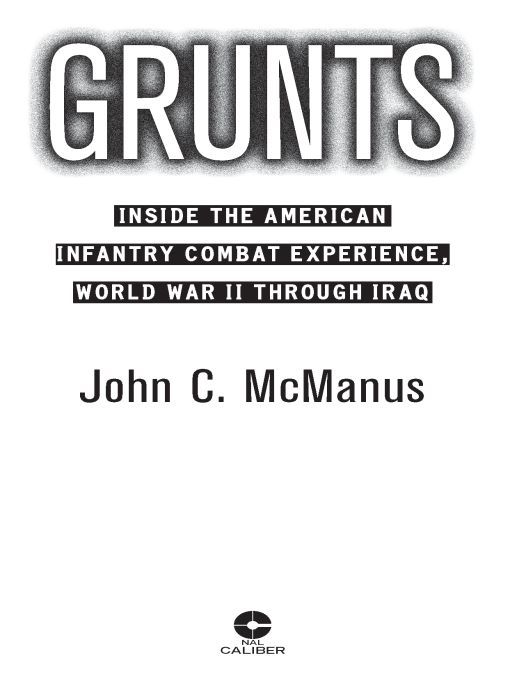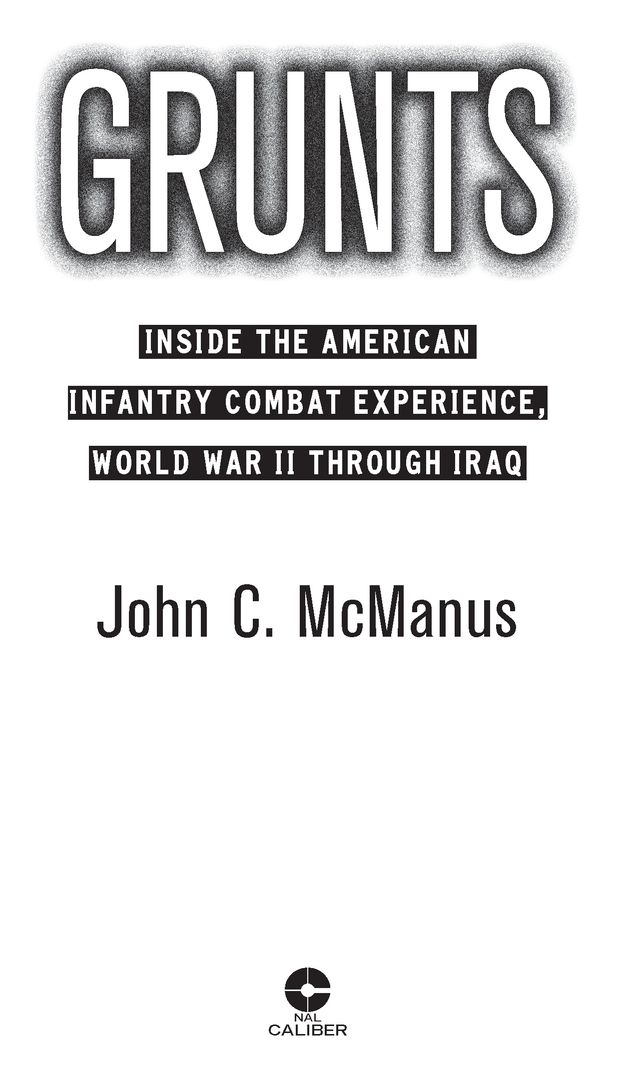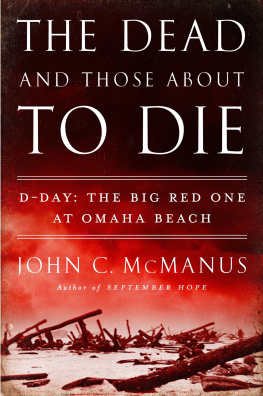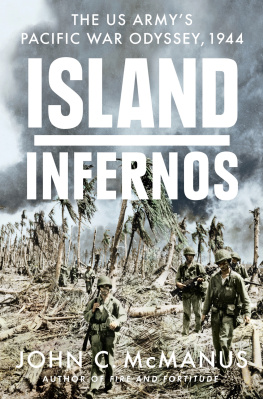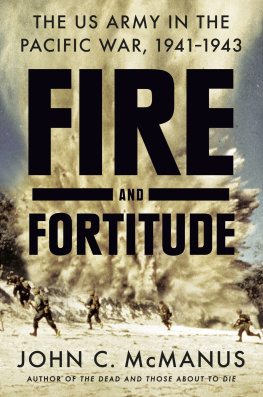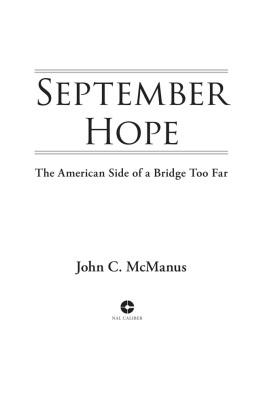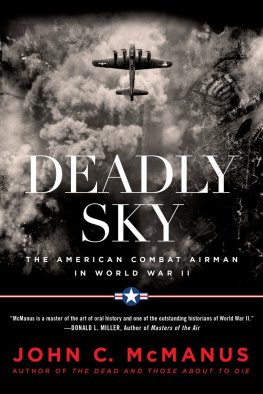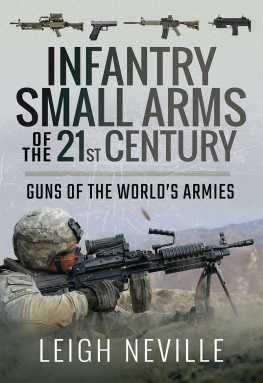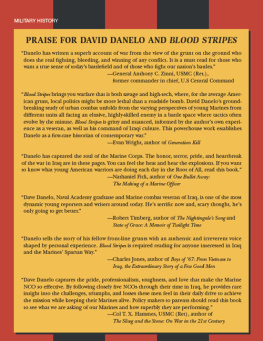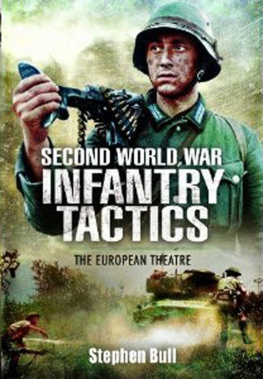Table of Contents
Also by John C. McManus
American Courage, American Carnage:
The 7th Infantry Regiments Combat Experience, 1812 Through World War II
The 7th Infantry Regiment:
Combat in an Age of Terror, the Korean War Through the Present
U.S. Military History for Dummies
Alamo in the Ardennes:
The Untold Story of the American Soldiers Who Made the Defense of Bastogne Possible
The Americans at Normandy:
The Summer of 1944The American War from the Normandy Beaches to Falaise
The Americans at D-Day:
The American Experience at the Normandy Invasion
Deadly Sky:
The American Combat Airman in World War II
The Deadly Brotherhood:
The American Combat Soldier in World War II
To Michael and Mary Jane McManus, who made all of this possible
To Charles W. Johnson, who taught and led like a great general
To the infantry sergeants, lieutenants and captains of multiple
generations who paid in blood, tears and anguish to teach us the
lessons we all should heed
Grunt: A United States Army or Marine foot soldier; one who does
routine unglamorous work
MERRIAM-WEBSTER DICTIONARY
Introduction
Facing Our Fears
THE MOST POWERFUL, EFFECTIVE WEAPON in modern war is a well-trained, well-armed, and well-led infantry soldier. To some this assertion might seem naive, simplistic, or even antiquated, perhaps an appropriate statement to make back in Washingtons or Wellingtons day, but surely not in our own era of dynamic technical sophistication. After all, how can the average foot-slogging grunt with a rifle in his hands possibly compare with the malevolent power of technologys deadly birthlings? Indeed, the variety of modern space-age weapons is impressive: nuclear bombs and missiles with the power to destroy civilization; deadly gases and biological concoctions that could eradicate human life as we know it; super aircraft carriers; nuclear-propelled and nuclear-armed submarines; high-performance fighter aircraft; intercontinental bombers; computer and electronic eavesdropping technology; net-war computer hackers with the power to paralyze information-age economies; laser-guided smart bombs and unmanned combat aircraft, not to mention the bevy of land weapons (artillery, tanks, missiles, and so on) that tower over the infantryman like an NBA center over a toddler.
Each one of these weapons exudes a tantalizing, magic-bullet simplicity to fighting and winning wars. In other words, the side with the most sophisticated and deadly weapons should automatically win. The newer the technology, the more devastating the weapon, the more antiquated the infantry soldier should become. This self-deceptive thinking is nothing new. In ancient times, generals expected the chariot to sweep foot soldiers from the battlefield. In medieval times, the mounted knight and artillery would do that job. Later, in World War I, machine guns, frighteningly accurate artillery, and poison gas were supposed to make the infantryman obsolete. Of course, the rise of aviation created a powerful new brand of techno-vangelism. In the 1930s, air power enthusiasts, such as Giulio Douhet and Hap Arnold, argued that henceforth fleets of airplanes would bring war to the enemys homeland, destroying his economy and his will to make war, thus negating any real need for armies.
The advent of nuclear weapons at the end of World War II seemingly elevated the victory through air power theory to an axiomatic level on par with Newtons scientific findings on gravity. Indeed, the mushroom clouds over Hiroshima and Nagasaki barely had time to dissipate before a new flock of futurists proclaimed this latest revolution in warfare. From now on, they claimed, wars would be fought by a combination of nuclear-armed airmen and push-button technicians collectively raining untold waves of destruction on the enemys populace. The day of the foot soldier is gone forever, one such visionary wrote in 1946. He is as extinct as the dodo bird. Yet this rather elementary fact seems to have escaped the notice of the hide-bound traditionalists who still cling tenaciously to their predilection for swarming masses of foot soldiers. Writing a few months later, another self-styled seer (an infantry officer, no less!) agreed that the days of the ground arms are ending. Warfare has changed. The scientists have taken over strategy and the military men have got to understand this sooner or later. The days of battles, as we know them and... have fought them, are gone forever. I must risk posing an acerbicor at least uncomfortablequestion: How did those prognoses work out? The answer is obvious. They could not have been more wrong if they had said elephants fly better than birds.
Predictions regarding the demise of the foot soldier are always wrong because they are based on theory, not actual events. There is an old saying that rules are meant to be broken. Well, I would argue that theories are meant to be debunked, especially in relation to warfare. As a historian, I am, quite frankly, not interested in the theoretical world of jargon-packed war college papers, geopolitical treatises, and predictions about next war wonder-weapons or scenarios. Instead, I am interested in finding out what actually happened, understanding why it happened that way, and perhaps coming to some kind of conclusion on what this might bode for the future. This book, then, is about realities of the modern battlefield, not theories about it. On the basis of historical study, I can say this with absolute certainty: From World War II through the present, American ground combat soldiers, especially infantrymen, have been the lead actors in nearly every American war, at the very time when new weapons and technology were supposed to make them obsolete.
Thus, even in modern war, more is usually less. Since World War II, no one has, thankfully, ever used nuclear weapons. Instead, nukes settled into a useful role as a terrifying deterrent, assuring potential antagonists mutual destruction if they were ever actually employed. Their existence probably dissuaded the Cold War superpowers from making all-out war on each other. Both the Soviets and the Americans understood the pointlessness, and the horrible consequences for humanity, of nuclear war. The same has largely been true for every other nuclear power (of course, nuclear-equipped, fanatical, extra-national terrorists would probably have no such compunctions). Saddam Hussein notwithstanding, chemical and biological weapons have also largely been absent from the modern battlefield. I am not arguing that this absence places them beneath consideration. I am simply saying that their existence does not negate the infantrymans vital importance. The same is true for the other techno-rich weapons I listed above. The armadas of bombers, ships, subs, missiles, and aerial drones, in spite of their staggering array of ordnance, and important though they are, have still never yet replaced the ground soldier as the primary agent of warfare. From the invasion beaches of Guam in 1944 to sweaty patrols in twenty-first-century Iraqi heat, the guy with boots on the ground and a weapon in his hand almost always takes the lead in carrying out the war aims of Washington policymakers, not to mention determining their success or failure. This is the pattern of recent history.

